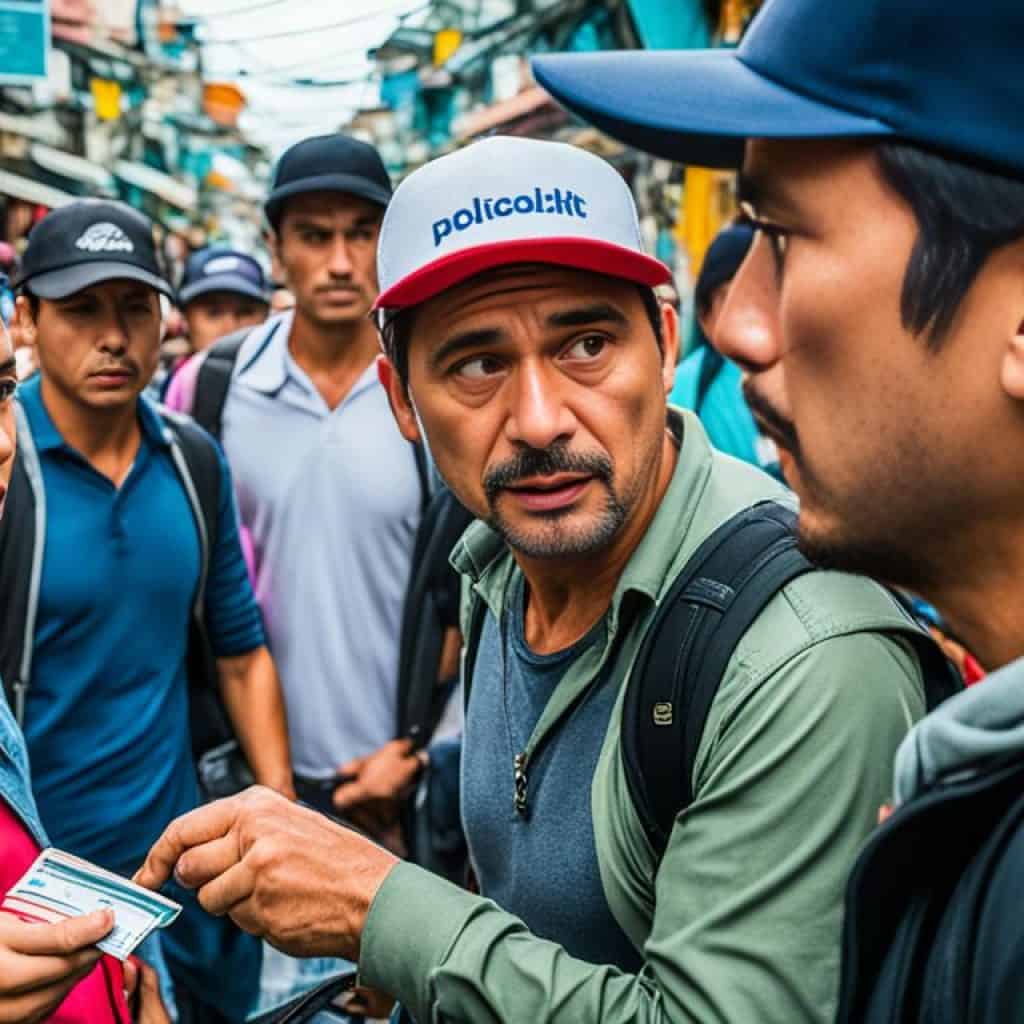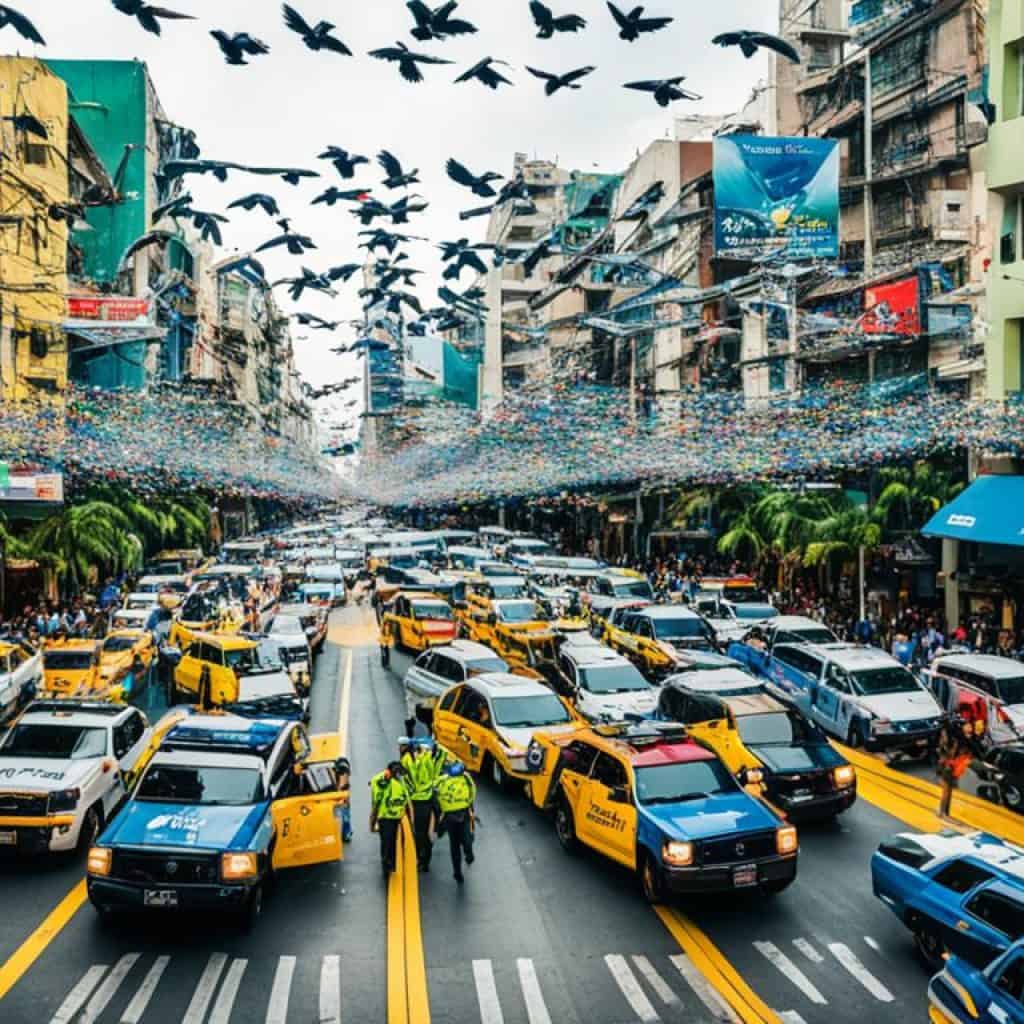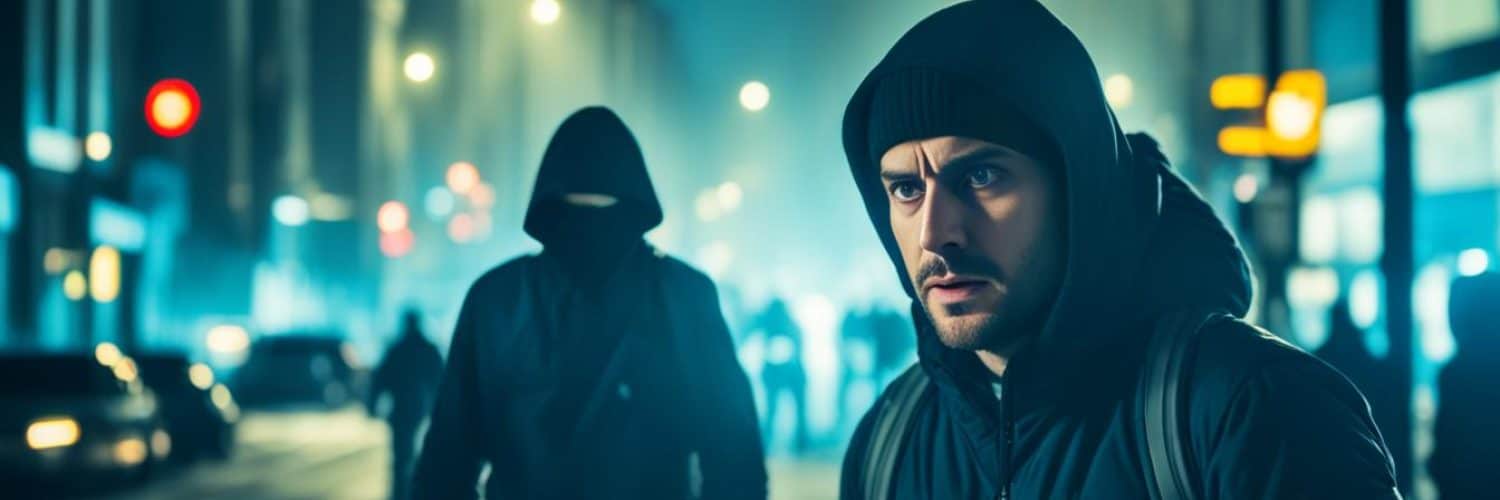Are you planning a trip to the beautiful Philippines? Before you go, have you considered the safety concerns in the country? With rising crime rates and various criminal activities, it’s crucial to be well-informed and prepared. In this article, we’ll explore the crime trends, safety concerns, and provide you with essential safety tips to ensure a secure experience in the Philippines.
Key Takeaways:
- Understand the crime rate and statistics in the Philippines
- Learn about the criminal activities that pose a threat to tourists and residents
- Discover crime prevention programs and the effectiveness of law enforcement
- Gain insights into the current crime trends in the country
- Explore the functioning of the criminal justice system in the Philippines
- Obtain safety tips to protect yourself from potential risks
Gun Crime in the Philippines
The Philippines faces a significant issue with gun crime. With over 600,000 unregistered firearms in the country, the presence of guns contributes to a high rate of violence. Homicide and armed robbery cases are particularly prevalent in Manila, the capital city, where dangerous street gangs operate.
To address the concern of gun crime in the Philippines, foreigners visiting the country should take necessary precautions to avoid becoming victims of robbery or violence. While most incidents occur in the city’s slums, it is crucial to exercise caution in all areas and not draw attention to valuables in public.
Personal safety should always be a priority. Whether you are a tourist or a resident, it is essential to remain vigilant and adopt measures to protect yourself and your belongings. By following these safety tips, you can reduce the risk of encountering gun-related crimes:
- Avoid displaying valuable objects openly.
- Stay aware of your surroundings and be cautious in crowded or unfamiliar areas.
- Use well-lit and populated streets when walking at night.
- Consider traveling in groups, especially during nighttime.
- Keep emergency contact numbers on hand.
By taking these precautions, you can minimize the chances of being a target for gun crime and ensure a safer experience while in the Philippines.
Illicit Drugs in the Philippines
The war on drugs in the Philippines has been a longstanding battle, with significant consequences and dangers for those involved. As part of the government’s efforts to combat drug crimes and drug trafficking, over 10,000 individuals have lost their lives in this ongoing campaign. The Philippines has taken a harsh stance on illicit drugs, and even being associated with drugs in any way can pose serious risks to travelers.
Possession of any amount of drugs can lead to imprisonment for up to four years. The government has implemented strict measures to crack down on drug trafficking, making it crucial for visitors to exercise caution and avoid involvement with illicit drugs in any form.
“The Philippines is committed to eradicating drug-related crimes that pose a significant threat to the safety and well-being of our citizens,” says President Rodrigo Duterte.
It is important for travelers to understand the severity of the situation and prioritize their safety. Awareness of the consequences of drug-related activities and complying with the local laws is essential to avoid legal troubles and ensure a secure visit to the Philippines.
Pickpockets in the Philippines
With widespread poverty in the Philippines, petty theft, including pickpocketing, is a prevalent issue. Foreign travelers, in particular, are often targeted by pickpockets, primarily in crowded areas and popular tourist attractions. It is crucial for visitors to keep their valuables secure and remain vigilant in crowded places. To deter pickpockets, consider using zippered pockets or a concealed fanny pack.

Pickpocketing is a common tactic used by thieves to snatch wallets, phones, and other valuable items without the victim’s knowledge. These criminals often work in groups and employ various techniques to distract their targets. For instance, one person might accidentally spill something on the victim while another picks their pocket.
To protect yourself from pickpockets in the Philippines, it is essential to take preventative measures. Here are some tips to keep in mind:
- Be mindful of your surroundings, particularly in crowded areas and tourist hotspots.
- Avoid displaying valuable items such as expensive jewelry, cameras, or large sums of money.
- Keep your belongings secure by using zippered compartments or bags with hidden pockets.
- Consider wearing a money belt or a concealed fanny pack to keep your valuables close to your body.
- Stay alert and trust your instincts. If someone appears suspicious or makes you feel uncomfortable, create distance and seek assistance if necessary.
By following these safety precautions, you can minimize the risk of falling victim to pickpockets and enjoy a more secure and worry-free experience during your visit to the Philippines.
ATM Skimming in the Philippines
The Philippines is unfortunately plagued by ATM skimming, a prevalent form of electronic theft that targets unsuspecting individuals using automated teller machines. Fraudsters attach discreet devices to ATMs to illegally obtain credit card information and personal identification numbers (PINs). This form of criminal activity poses a significant threat to both locals and tourists.
Travelers visiting the Philippines should exercise caution and take necessary precautions to protect themselves from credit card fraud and electronic theft. To minimize the risk:
- Choose ATMs attached to banks: ATMs located within the premises of reputable banks tend to have higher levels of security and surveillance, making them less vulnerable to skimming devices.
- Inspect the ATM: Before using an ATM, visually inspect it for any irregularities or suspicious devices attached to the card reader or keypad. If something appears out of the ordinary, it’s best to find an alternative ATM.
- Cover the keypad: Shield the keypad with your hand as you enter your PIN, making it difficult for any hidden cameras to capture your keystrokes.
- Monitor your bank accounts: Regularly review your bank account statements and transaction history to identify any unauthorized activity. Immediately report any suspicious charges or withdrawals to your bank.
By staying vigilant and following these safety measures, travelers can reduce the risk of falling victim to ATM skimming and protect their financial information from being compromised.
| Methods to Protect Against ATM Skimming | Effectiveness |
|---|---|
| Choosing ATMs attached to banks | Highly effective |
| Inspecting the ATM for irregularities | Highly effective |
| Covering the keypad when entering PIN | Highly effective |
| Monitoring bank accounts for unauthorized activity | Highly effective |
Drink Spiking in the Philippines
When it comes to enjoying the vibrant nightlife of the Philippines, it’s important for tourists to be aware of the issue of drink spiking. This disturbing act is unfortunately prevalent in busy bars and nightclubs across the country, posing a significant risk to unsuspecting individuals.
Criminals who engage in drink spiking often use sedatives or other substances to render their victims unconscious or incapacitated. Once the victim is affected by the spiked drink, they become vulnerable to various dangers, including theft, assault, or worse.
Protect Yourself: Tourist Safety Tips
To safeguard your well-being and reduce the risk of falling victim to drink spiking in the Philippines, consider these important safety tips:
- Never accept drinks from strangers.
- Keep a constant eye on your beverage; never leave it unattended.
- If someone offers to buy you a drink, accompany them to the bar and watch as the drink is prepared.
- Trust your instincts. If a drink tastes strange or you suddenly feel unusually dizzy or disoriented, stop drinking immediately.
- Seek help from a trusted friend, the venue’s security personnel, or the local authorities if you suspect your drink has been spiked.
Stay Vigilant and Protected
By following these safety precautions and being aware of the risks associated with drink spiking in the Philippines, you can reduce the likelihood of becoming a victim. Remember, your personal safety is of utmost importance, so always prioritize your well-being when engaging in nightlife activities.
| Type of drink spiking substance | Effects on victims |
|---|---|
| Rohypnol (roofies) | Loss of consciousness, memory loss, confusion, dizziness |
| Ketamine | Disorientation, hallucinations, loss of coordination |
| GHB (gamma-hydroxybutyric acid) | Drowsiness, dizziness, memory loss, increased suggestibility |
| Various sedatives or hypnotic drugs | Loss of inhibitions, impaired judgment, sedation |
Remember, tourists should always prioritize their personal safety while enjoying the nightlife in the Philippines. Be cautious, stay vigilant, and trust your instincts when it comes to your well-being.
Terrorism in the Philippines
The southern Philippines, particularly Mindanao, has been plagued by violent Islamic terrorists, such as the Abu Sayyaf Group. These terrorist organizations pose a significant threat to the safety and security of both locals and tourists. It is crucial for travelers to exercise caution and stay informed about the risks associated with terrorism in the region.
It is advised to avoid crowded places that are attractive targets for terrorist attacks, such as shopping centers, nightlife areas, and busy markets. These locations are often targeted due to the high concentration of people, which increases the potential impact and casualties of an attack. By staying away from these areas, tourists can minimize their exposure to such threats.
Additionally, it is essential to stay updated on travel advisories issued by the respective government agencies of your home country and the Philippines. These advisories provide important information regarding the current security situation in the country and any specific areas that should be avoided. It is recommended to register with your embassy or consulate, as they can provide valuable assistance in case of emergencies.
Local authorities and law enforcement agencies play a crucial role in maintaining security and combating terrorism. Travelers should cooperate and follow their guidance at all times to ensure personal safety. Being aware of emergency contact numbers and having a contingency plan can also prove to be vital in case of any unforeseen situations.
It is important to note that while the threat of terrorism exists in certain parts of the Philippines, the majority of the country remains safe for travel. By staying informed, exercising caution, and following the guidance of local authorities, tourists can still enjoy their visit to this beautiful archipelago.
Terrorist Groups in the Philippines
The Philippines is home to several terrorist groups that pose a significant threat to security. Among these groups, the Abu Sayyaf Group (ASG) is one of the most notorious. ASG is an extremist Islamic organization primarily based in the southern Philippines, particularly in the provinces of Basilan, Sulu, and Tawi-Tawi.
“The Abu Sayyaf Group is notorious for its involvement in kidnappings for ransom, bombings, and other acts of violence. They primarily target foreigners and have been responsible for several high-profile attacks, causing significant casualties.”
The group has conducted kidnappings, bombings, and other acts of violence, primarily targeting foreigners. They have been responsible for numerous attacks, resulting in casualties and disrupting peace and stability in the region. ASG’s main sources of funding include kidnapping-for-ransom operations.
It is important for travelers to be aware of the presence and activities of these terrorist groups in the Philippines. By staying informed and taking necessary precautions, tourists can mitigate the risks associated with terrorism and enjoy a safer travel experience.
Travel Warnings for the Philippines
Many countries, including the United States, Canada, Australia, and the United Kingdom, issue travel warnings for the Philippines. These travel warnings are designed to provide important information and advice to citizens planning to visit or already present in the country.
“Travel warnings for the Philippines highlight the risks associated with terrorism, criminal activities, and other safety concerns. They provide valuable guidance on areas to avoid and precautions to take, keeping travelers informed and prepared.”
It is recommended to consult the travel advisory issued by your home country’s government before planning a trip to the Philippines. These advisories typically provide up-to-date information on security risks, including terrorism, and highlight specific regions or areas to avoid. Travelers should carefully read and follow the advice provided to ensure their safety during their stay in the country.
By staying informed, being vigilant, and following the guidance of local authorities and travel advisories, tourists can reduce their exposure to terrorism risks and enjoy a safer travel experience in the Philippines.
| Terrorist Group | Activities |
|---|---|
| Abu Sayyaf Group (ASG) | Kidnappings for ransom, bombings, violent attacks |
| Maute Group | Militant extremist activities, involvement in the Marawi Siege |
| New People’s Army (NPA) | Communist insurgency, attacks against government forces |

Disclaimer: The provided image is for illustrative purposes only and does not depict specific incidents or locations related to terrorism in the Philippines.
Pirates in the Philippines
Due to its numerous islands and secluded areas, the Philippines is susceptible to piracy. Pirates operate in the Sulu and Celebes seas, targeting fishing trawlers, cargo ships, and pleasure boats. Tourists should be cautious about taking boat trips in these areas, especially in the Sulu Sea. It is advisable to choose well-regulated and reputable boat operators.
Maritime Crime in the Sulu and Celebes Seas: Targets and Risks
| Piracy Targets | Risks |
|---|---|
| Fishing trawlers | Risk of hijacking, crew abduction, and theft of equipment and catch |
| Cargo ships | Risk of armed robbery, cargo theft, and crew kidnapping for ransom |
| Pleasure boats | Risk of piracy attacks, theft, and hostage situations |
Piracy in the Philippines poses a significant threat to maritime activities in the Sulu and Celebes seas. Fishing trawlers, cargo ships, and pleasure boats are prime targets for pirates seeking financial gain through theft, hijacking, or kidnapping for ransom.
For fishing trawlers, pirates may hijack vessels and steal equipment, catch, and personal belongings. Crew members may also face the risk of abduction, which can result in extended captivity and potential harm.
Cargo ships are vulnerable to armed robbery and cargo theft. Pirates often board these vessels, overpower the crew, and plunder valuable goods intended for transportation. Crew members may also be kidnapped and held for ransom, subjecting them to physical and mental distress.
Even pleasure boats are not immune to piracy attacks. Tourists on recreational trips may encounter criminal activities such as theft, piracy incidents, and in extreme cases, hostage situations. It is crucial for individuals considering boat trips in the Sulu and Celebes seas to assess the risks and take precautions to ensure their safety.
Tips for Safe Boat Trips in the Philippines
- Choose well-regulated and reputable boat operators with a proven track record of safety.
- Research the current security situation in the specific areas you plan to visit.
- Stay updated on any travel advisories or warnings issued by local authorities or foreign embassies.
- Inform someone trustworthy about your boat trip plans, including the estimated duration and expected return time.
- Avoid traveling alone and opt for group tours whenever possible.
- Ensure you have access to reliable communication devices in case of emergencies.
- Always carry personal identification and keep important documents secure.
- Stay vigilant and report any suspicious activities to the authorities.
Travelers should prioritize their safety and be cautious when considering boat trips in the Sulu and Celebes seas. By following these tips and staying informed, individuals can minimize the risks associated with piracy in the Philippines.
Kidnappings in the Philippines
Kidnappings have long been a problem in the southern Philippines, especially in connection with piracy and terrorism. The Abu Sayyaf Group, a notorious extremist organization, has gained notoriety for its involvement in kidnappings for ransom. Targeting both Filipinos and tourists, the group has caused fear and instability in the region.
Travelers to the Philippines should exercise caution, especially when visiting areas prone to kidnappings. It is crucial to stay updated on travel advisories and avoid isolated or high-risk areas. By being vigilant and following local authorities’ guidance, individuals can reduce the risk of becoming victims of abduction.
The Abu Sayyaf Group operates primarily in the remote islands of the Sulu Archipelago and Mindanao, where they carry out kidnappings with the intention of financing their extremist activities. They often target foreigners, particularly those engaged in maritime activities, such as sailors and divers.
To ensure personal safety, it is advisable to stick to well-traveled routes, stay in groups, and avoid traveling alone in unfamiliar areas. Sharing travel plans with trusted individuals and registering with the local embassy or consulate can also provide an additional layer of security.
“Kidnappings have had a significant impact in the southern Philippines, making it crucial for travelers to remain cautious and well-informed about the risks associated with abduction.” – Travel Security Expert
It is essential to stay alert to one’s surroundings and be cautious of suspicious activities or individuals. In case of an emergency or if you witness any suspicious behavior, report it to local authorities immediately. By taking these precautions, individuals can better protect themselves and mitigate the risk of becoming victims of kidnappings in the Philippines.
Security Tips to Prevent Kidnappings:
- Be aware of your surroundings and stay vigilant at all times.
- Stick to well-traveled routes and avoid isolated or high-risk areas.
- Travel in groups or with a trusted guide in unfamiliar areas.
- Share travel plans with trusted individuals and register with the local embassy or consulate.
- Avoid displaying signs of wealth or carrying expensive items that may make you a target.
- Keep a low profile and avoid drawing unnecessary attention to yourself.
- Stay updated on travel advisories and follow the guidance of local authorities.
- Report any suspicious activities or individuals to the local authorities immediately.
Safety Concerns in Manila
Manila, the capital city of the Philippines, is a vibrant and bustling metropolis that attracts tourists from all over the world. However, like any other major city, Manila has both safe and dangerous areas that visitors should be aware of. By exercising caution and taking necessary safety precautions, tourists can have a more secure and enjoyable experience in Manila.
One of the neighborhoods that tourists should be cautious about is Tondo. Tondo is known for its high crime rates and poverty. It is advisable to avoid this area, especially if you are not familiar with the surroundings. Another neighborhood to avoid is San Andres, which also has a relatively higher crime rate. These slum areas can be unsafe for visitors, and it is important to prioritize personal safety and well-being.
When exploring Manila, it is crucial to keep your valuables hidden and secure. Avoid displaying expensive jewelry, gadgets, or large amounts of cash in public areas. Pickpocketing and theft can occur in crowded places such as markets, shopping centers, and public transportation. By being mindful of your surroundings and keeping your possessions secure, you can minimize the risk of becoming a target for criminals.
Additionally, it is always a good idea to stay in well-populated and well-lit areas, especially at night. Stick to main roads and avoid walking alone in secluded areas. It may also be helpful to research and plan your routes in advance to avoid getting lost in unfamiliar neighborhoods.
Remember, safety is a priority, and being cautious does not mean you cannot enjoy everything Manila has to offer. By taking necessary precautions, you can have a wonderful and memorable experience exploring the vibrant culture, delicious cuisine, and rich history that Manila has to offer.
| Neighborhood | Safety Rating | Description |
|---|---|---|
| Tondo | Low | Tondo is known for its high crime rates and poverty. It is advisable to avoid this area, especially if you are not familiar with the surroundings. |
| San Andres | Moderate | San Andres has a relatively higher crime rate. It is recommended to exercise caution when visiting this neighborhood. |
Remember, safety is a priority, and being cautious does not mean you cannot enjoy everything Manila has to offer. By taking necessary precautions, you can have a wonderful and memorable experience exploring the vibrant culture, delicious cuisine, and rich history that Manila has to offer.

Stay vigilant, keep your valuables secure, and enjoy your time in the exciting city of Manila!
Travel Advisories for Mindanao
Mindanao, the second-largest island in the Philippines, is known for its complex security issues. Travelers should be aware of the various travel advisories and safety concerns associated with the region. In particular, Western Mindanao is advised against due to ongoing violent incidents such as bombings, kidnappings, and attacks by extremist groups.
While there are areas to exercise caution in Mindanao, it is important to note that not all parts of the island are considered high-risk. The city of Davao in southeast Mindanao, for example, is generally considered safe for travelers. However, even in relatively safe regions, it is still advisable to exercise caution and stay informed about any recent developments or travel advisories.
To ensure your safety while visiting Mindanao:
- Stay updated on the latest travel advisories and warnings for the region.
- Avoid traveling to high-risk areas, particularly in Western Mindanao.
- Exercise caution and remain vigilant at all times.
- Follow the guidance of local authorities and security forces.
By staying informed and taking necessary precautions, you can have a safer and more enjoyable experience while traveling in Mindanao. It is important to prioritize your personal safety and make well-informed decisions throughout your journey.
Quote:
“Safety should always be a top priority when traveling to Mindanao. Stay informed, heed travel advisories, and exercise caution to ensure a memorable and secure trip.”
Traveling Safely in the Philippines
While the Philippines may have some security challenges, it is important to remember that with the right precautions, you can still travel safely and enjoy all that this beautiful country has to offer. By following a few key safety tips and staying informed, you can have a worry-free experience during your visit.
General Safety Tips:
- Keep your valuables hidden: Avoid drawing unnecessary attention to yourself and your belongings by keeping valuable items concealed.
- Avoid isolated or high-risk areas: Stay in well-populated and tourist-friendly areas, especially at night.
- Stay updated on travel advisories: Check for any relevant travel advisories and follow the guidance provided by local authorities.
- Travel with a reputable tour operator: If you’re unsure about navigating certain areas, consider booking tours with trusted companies who are familiar with the local environment.
- Follow local laws and regulations: Respect the laws and customs of the Philippines during your stay to avoid any unnecessary complications.
“Safety doesn’t happen by accident. It’s a choice. Take the necessary precautions and enjoy your time in the Philippines with peace of mind.” – Anonymous
By keeping these tips in mind and staying alert, your trip to the Philippines can be a safe and memorable experience. Remember, it’s always better to be prepared and aware of your surroundings. Enjoy your adventure in the Philippines!
Conclusion
Crime in the Philippines is a serious concern that tourists and residents need to be aware of. From gun violence and illicit drugs to pickpocketing and terrorism, there are potential risks that individuals should take seriously. It is crucial to stay informed and exercise caution while in the country to ensure personal safety and security.
By following safety tips such as keeping valuables hidden, avoiding isolated or high-risk areas, and staying updated on travel advisories, visitors can better protect themselves during their time in the Philippines. It is also advisable to travel with reputable tour operators and adhere to local laws and regulations.
While the country faces challenges, it is still possible to have a secure experience in the Philippines. By taking necessary safety precautions and being vigilant, individuals can minimize the risks associated with crime and have a more enjoyable and peaceful stay in this beautiful country.


















Add comment